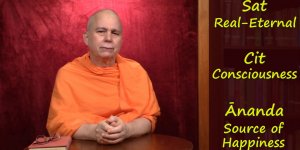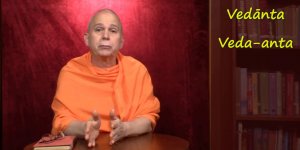| / Documentaries / Philosophy, Religion |
Introduction to Advaita Vedanta
Part 4/6: Sakshi - The Awareful Witness
A video presentation by Swami Tadatmananda Saraswati, Arsha Bodha Center, United States
(Tapescript) Welcome! In the previous presentations, we explored the nature of atma, your true self, the consciousness that’s the essence of your being and ultimate source of happiness.
Using the teachings of Vedanta, we discovered this conscious self to be completely independent of your body and mind as the unchanging observer of your mind’s constantly changing activities.
As the unchanging observer, atma is utterly unaffected by your mind’s activities, like the sun is utterly unaffected by all it illumines.
In this presentation, we’ll broaden our perspective, going beyond the individual body and mind to explore the limitless, all-pervasive nature of consciousness.
All experience actually takes place in your mind. In fact, the only things you can directly experience are the activities of your mind. The world around you is experienced only indirectly, by means of your five senses - sight, hearing, taste, smell, and touch. Without these sense faculties, you couldn’t experience the world at all.
Each of your five senses conveys information about the world to your mind, where these perceptions become known to you as mental objects, which are called vrittis in Sanskrit.
These vrittis are mental representations of the various colors, sounds, smells, etcetera in the world around you.
You directly know the presence of these vrittis in your mind, and with the help of these vrittis, you gain indirect knowledge of the world around you. For example, right now, you’re watching me on a screen. But in order to see me, an incredibly complex process has to take place.
First of all, light from the screen has to reach your eyes, where lenses on the front of each eyeball can then focus a tiny inverted image of me onto the back surface of each eye, where the retina is found.
Then, the so-called rods and cones in those retinas convert those two tiny, upside-down images of me into electrical impulses that travel along your optic nerves.
Impulses from your right eye go to the left occipital lobe of your brain, and impulses from your left eye go to the right lobe. This process is so convoluted, it’s amazing that we can see anything at all.
Right now, two tiny, upside down, reversed images of me are creating electrical impulses in the neurons of your brain.
Is that what you’re experiencing right now? Of course not. You see one normal-sized right-side up image of me. But that image isn’t in your brain, it’s in your mind.
You don’t experience the firing of neurons in your brain, you experience an image of me that arises in your mind.
In this way, everything you directly experience takes place in your mind alone. The only time you might directly experience your brain itself is if you get a migraine headache.
So, your faculty of sight produces an image of me in your mind. That image is in the form of a mental object, a vritti. And that vritti is known by you, it’s observed by you.
You are the conscious observer or awareful witness who knows the presence of that vritti in your mind.
We use the word sakshi for the conscious observer or awareful witness. Therefore, you are the sakshi, the awareful witness, of the image of me present in your mind right now in the form of a vritti.
In addition to images produced by your sense of sight, your other faculties - hearing, taste, smell and touch - also produce vrittis in your mind.
Your sense of hearing produces vrittis that represent sounds, including the sound of my voice that you hear right now.
Your senses of smell and taste produce vrittis that represent various odors and flavors.
And your sense of touch produces vrittis that represent sensations of warmth and coolness, wetness and dryness, roughness and softness, and so on.
All these sense objects perceived by you arise in your mind as vrittis, and those vrittis become known to you, the conscious observer, sakshi.
In addition to these perceptions, all your cognitions or thoughts also arise in your mind as vrittis and become known to you. When you’re engaged in planning, evaluating, decision making, etcetera, all these activities take place in your mind, and are known to you, the conscious observer.
In the same way, your emotions, too, arise in your mind as vrittis. Happiness, sadness, anger and joy all appear in your mind as vrittis and become known to you as feelings.
Thus, you are the sakshi, the awareful witness or conscious observer of all activities that take place in your mind, your perceptions, cognitions, and emotions.
Now, we’re ready to proceed by using one of Vedanta’s most powerful and profound teaching methodologies. This method entails a careful examination of your mind’s three distinct conditions or states.
Those states are jagrat, the waking state, svapna, the dream state, and sushupti, deep dreamless sleep.
So far, our discussion has been focused on jagrat, the waking state.
In the waking state, as you interact with the world around you, everything you experience arises as vrittis in your mind and is observed by you, the awareful witness, sakshi.
Then, in the dream state, svapna, you continue to observe vrittis in your mind, but those vrittis are produced by your dreams. While you're dreaming, your five senses don’t function at all, so no vrittis can arise due to perceptions of the world around you.
Yet, whenever you dream, you still perceive lots of things - people, buildings, sounds, smells, and so on. These perceptions don’t come from the physical word; they come from memories of things you experienced when you were awake.
While you dream, in addition to these perceptions, various thoughts and emotions also arise in your mind, and are likewise observed by you, the awareful witness, sakshi.
But, what happens in deep dreamless sleep?
Every day, while you’re awake, you observe countless perceptions, cognitions and emotions as they arise as vrittis in your mind. During the dream state, too, you observe all the vrittis produced by your dreams.
Then, what happens in sleep when your dreams come to an end?
You observe nothing! Just as you observed the activities of your mind during the waking and dream states, in deep sleep, you observe the complete absence of activity in your mind.
You continue to observe the contents of your mind, but there’s nothing to be observed - no perceptions, no cognitions, and no emotions whatsoever.
That means, you remain completely conscious in deep sleep, but there’s nothing to be conscious of.
This assertion contradicts the common notion that deep sleep is a state of unconsciousness. But, the teachings of Vedanta can firmly support the fact that you remain conscious in deep sleep.
As we discussed before, to reveal your constantly changing vrittis, consciousness itself must be unchanging. And if consciousness is unchanging, then how can it turn off, so to speak, during deep sleep, and then turn back on during the waking and dream states? Consciousness isn't like the light bulb in your refrigerator that turns off every time you shut the door.
The unchanging consciousness that continually reveals each and every vritti while you're awake or dreaming, also reveals the complete absence of vrittis during deep sleep.
Here’s a helpful example. Imagine your mind to be like a room, filled with furnishings. The table, chairs, lamp, and so on represent your vrittis. Standing inside the room, you observe its contents, just like you, the awareful witness, sakshi, observe all the vrittis in your mind.
Standing in the room, you see not only its furnishings, but you can also look through the window, and see what’s happening outside. The window represents your five senses which enable you to perceive the world around you.
This scenario represents the waking state, jagrat, when you observe all the vrittis in your mind, including vrittis produced by your five senses.
Next, let’s consider the dream state, svapna. When the curtains in the room are closed, you can no longer look through the window and see outside. In the same way, in the dream state, when your senses are inactive, you can no longer perceive the world around you.
Yet, while you dream, you continue to perceive people, buildings, and other things as they arise as vrittis in your mind. But, these vrittis aren't produced by your senses; they come from your memories of things you experienced when awake. That’s like looking at a photograph, hanging in the room, of what you saw earlier, when you looked out through the window before the curtains were closed.
Now, suppose you’re standing in the same room, but it’s been radically transformed; all the furnishings have been removed, the walls have been painted with a non-reflective black paint, the beige curtain has been replaced with a black one. Even the floor has been painted black.
On the far side of the room, out of your view and not visible in this image, a lamp continues to shine, and the lamp fills every corner of the room with light.
As you stand in the well-lit perfectly black room with your eyes wide open, what do you see?
Nothing! You continue to see, but there’s no longer anything to be seen.
This scenario illustrates what happens in deep sleep, sushupti, when you, the awareful witness, continue to observe the contents of your mind, but your mind has become perfectly silent, absolutely still.
As I said before, in deep sleep, you continue to be conscious, but there’s nothing to be conscious of.
So, you, the awareful witness or sakshi, are the observer of whatever happens in your mind during all three states of waking, dream, and deep sleep.
These three states continue to alternate, taking turns every day and night, throughout your life. Eventually, of course, when you die, this cycle of waking, dream, and deep sleep will come to an end.
After death, when your brain and mind cease to function, you, the awareful witness, will continue to be conscious, but just as in deep sleep, there will be nothing to be conscious of. You will be aware of the absence of anything whatsoever, like standing in the black room with your eyes wide open.
From this, we can infer that the experience of being dead is similar to the experience of deep sleep.
But then, according to the doctrine of karma, you’ll eventually be reborn, with a new body. And once again, you’ll continue to witness the alternation of the three states - waking, dream, and deep sleep.
Thus the cycle goes on, and on, and on, until the time of liberation, moksha.
Now we come to the last topic in this presentation.
Suppose we sat down together to talk about all this, and I asked you, “How tall is consciousness? How wide is it?”
You’d probably say, “Consciousness doesn’t have dimensions like height and width.”
By saying this, you’d correctly state a fundamental truth, a truth that has far-reaching consequences.
Consider the fact that anything that lacks dimensions like height and width, can have no edge or border. That which is dimensionless is free from any boundary or limit. And that which has no boundary or limit is limitless. Besides that, whatever is limitless must be all-pervasive, like space.
Based on this, consciousness, which has no dimensions, is infinitely vast.
But then you might object, by saying, “Consciousness can’t be all-pervasive. It’s limited, because it only pervades the physical body. Consciousness really does have an edge - at the surface of your skin.”
Well, if you were to make that objection, you probably didn’t watch the second in this series of presentations, which painstakingly demonstrated the fact that the apparent limitation of consciousness to the confines of your body is a mere side effect that occurs due to the nature of the nerves in your skin.
It’s absolutely true that the sense of touch is limited to your body, but that doesn’t prove that consciousness is limited to your body.
Then, you might raise another objection, like this: “If consciousness is limitless and all-pervasive like space, then it has to pervade everyone’s body simultaneously. If consciousness really pervaded both our bodies right now, I’d be able to feel sensations in your body, and you’d be able to feel sensations in mine.”
Hmm. That’s a very good question, and we’ll have to answer it carefully.
First of all, what does it mean to experience bodily sensations?
We already saw how each of your five senses - sight, hearing, taste, smell, and touch - produce vrittis that arise in your mind. So, the sensations from YOUR body arise as vrittis in YOUR mind, and the sensations from MY body arise as vrittis in MY mind.
Since our minds are separate, our experiences will also be separate, even though consciousness pervades both our bodies simultaneously.
Since you seem to be in an argumentative mood, you might raise yet another objection, like this: “The vrittis that arise in the mind become known because they’re illumined or revealed by consciousness, as you’ve already said. If consciousness is all-pervasive, then, since it’s everywhere, it would illumine the thoughts in your mind and my mind simultaneously. But, if consciousness simultaneously illumines your thoughts and my thoughts, then why can’t we know each other’s thoughts?”
That’s another good question.
First of all, it’s a really good thing that we can’t know each other’s thoughts. Imagine what life would be like if we constantly knew what everyone else was thinking! Too much!!
Now, when you ask, “Why can’t we know each other’s thoughts?” who is it that is asking this question? Does consciousness itself ask the question, or, is this question a vritti that arises in your mind?
As we saw before, consciousness is unchanging, and unchanging consciousness can’t suddenly get a question, like, “Why don’t I know your thoughts?”
So, this question is actually a product of your MIND, and YOUR mind is certainly different and separate from MY mind, and all other minds.
But then, you might raise yet one more objection, by saying, “If my consciousness is all-pervasive, and your consciousness is all-pervasive, then my consciousness would illumine the thoughts, not only of my mind, but in yours as well, and your consciousness would also illumine the thoughts in both our minds. Then, how can we tell the difference between your consciousness and my consciousness?”
Very good question!
If we each had a separate all-pervasive consciousness, both of them would overlap each other, and what a confusing mess that would be!
However, as the ancient rishis discovered, there is but one all-pervasive consciousness, and that same one consciousness is responsible for simultaneously illumining each and every mind.
That shining consciousness becomes manifest or reflected by each individual mind, like the shining sun gets reflected by so many oceans, lakes, rivers and ponds.
Each individual body of water reflects the sunlight, and by doing so, each body of water itself becomes another source of light.
In the same way, each individual mind reflects the same one all-pervasive consciousness, and by doing so, each mind gains sentiency.
So, there’s only one source of consciousness, but there are countless reflections in countless minds.
And just like each body of water reflects the sunlight differently depending on its size and shape, in the same way, consciousness is reflected differently by each of our minds.
Even though consciousness is one, we feel like individual conscious beings, because of the separateness and distinctiveness of our individual minds.
These teachings are amongst the loftiest revelations of the rishis.
One of those revelations is recorded in this profound passage from the Shvetashvattara Upanishad: eko devah, there is but one shining consciousness.
The word deva is used here not with reference to god but in its root meaning, That which shines. Here, deva means shining consciousness.
That one shining consciousness is sarva-bhuteshu gudhah, it is gudhah, hidden, residing within, sarva-bhuteshu, in all creatures.
That one same consciousness, which is the essence of our being, dwells in us all and simultaneously illumines the activities of each of our minds.
Continuing, that one consciousness is sarva-vyapi, all-pervasive, boundaryless, limitless.
And it is sarva-bhuta-antaratma, it is the antaratma, the inner self, of sarva-bhuta, all creatures.
This atma, the true self, is frequently referred to as the divinity that dwells within us all.
It’s divine because it is unborn, uncreated, and infinitely vast. It is unchanging, unaffected by all it illumines, and it's the true source of happiness, contentment and peace.
This is the vision of the ancient rishis, which we can discover with the help of their teachings, by following in their footsteps.
YOU MAY ALSO LIKE





